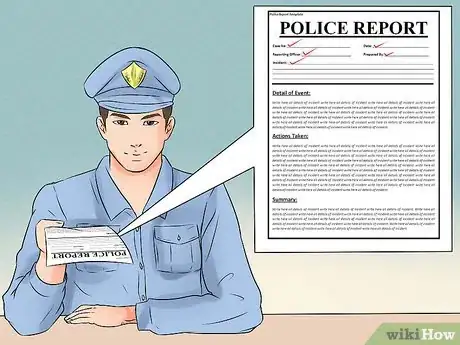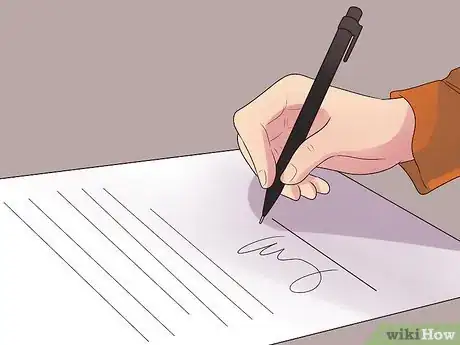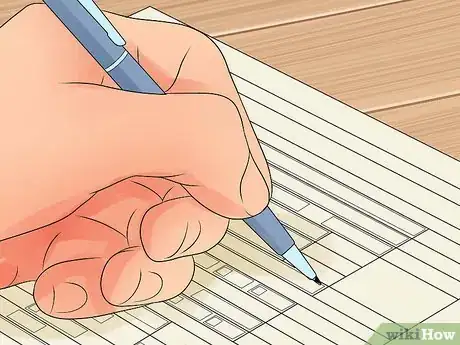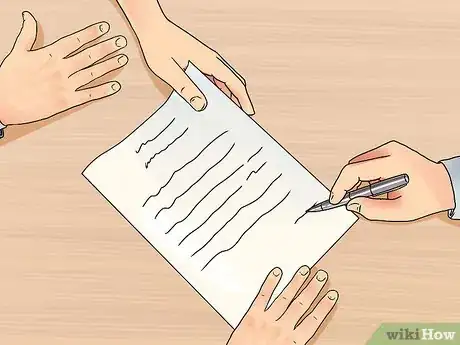This article was written by Jennifer Mueller, JD. Jennifer Mueller is an in-house legal expert at wikiHow. Jennifer reviews, fact-checks, and evaluates wikiHow's legal content to ensure thoroughness and accuracy. She received her JD from Indiana University Maurer School of Law in 2006.
There are 8 references cited in this article, which can be found at the bottom of the page.
This article has been viewed 17,578 times.
If you've been the victim of an assault, you probably have concerns for your safety and well-being, as well as the safety of loved ones. Before you do anything, make sure you are in a safe place and have protection in the event the person who assaulted you comes after you again. Once you're safe, you should immediately turn your focus to reporting the assault to the proper authorities so the person won't bother you again.
Steps
Filing Charges with Law Enforcement
-
1Gather information and witnesses. Write down an account of everything that happened as soon as practical after the assault.
- Make a record of the entire event, including the circumstances surrounding it or leading up to it, as soon as possible after it happened so the events are as fresh as possible in your mind.
- Talk to anyone around who saw what happened and ask if they'll be willing to testify on your behalf.
- Take pictures of any injuries you have as soon as you can after the altercation occurred and as they develop.
- If you were injured, go to a doctor or medical clinic as soon as possible so you can be treated and also have a medical record of your injuries.[1]
-
2Understand your state's definition of assault. Each state statute defines the crime of assault somewhat differently. Try to have a good idea of what your state considers an assault before you report your altercation as such.
- Generally, the legal definition of assault involves intentionally causing another person to fear imminent harm. In some states, assault also includes attempting to cause physical injury.
- However, in other states and in popular usage, the term assault includes intentionally causing someone physical injury – rather than simply attempting to do so and failing.[2]
- Different degrees of assault also vary from state to state.[3]
Advertisement -
3Go to your local police department. Make a visit to your nearest police department, or call the non-emergency line if you cannot make the trip in person.
- Keep in mind that reporting your assault is no guarantee that charges will be filed against the person who assaulted you.
- Although a report may bring you a sense of closure, reporting of or even conviction for assault won't fully protect you or keep the person from coming after you again.[4]
- If you want charges filed against the person who assaulted you, make your report as soon as possible. The crime of assault has a statute of limitations, which provides a deadline for filing charges. After the deadline has passed, the state can't charge the person who assaulted you with a crime. Statutes of limitations vary from state to state but may be as short as 30 days.[5]
-
4Provide the information requested. When you make your initial report, a police officer will ask you a number of questions about the assault and the person you allege assaulted you.
- Some of the information you will likely be asked to provide includes your name and contact information, the name and contact information (if known) of the person who assaulted you, and the date, time, and location of the assault.[6]
- The officer also will want to know exactly what happened in as much detail as you can remember. This is why writing everything down as soon as you could after it happened is so important. Use that written account, and try to recall as much as you can, but don't embellish or include details you're not sure about.
- Police officers may conduct further investigations of the incident to uncover additional information.[7]
- Depending on the type of assault you allege, police officers may want to interview you several times.[8]
-
5Cooperate with any ensuing investigation. After your initial report, you may receive requests for additional information from a police investigator working on your case.
- Once the police have completed their investigation, they will send you copies of any reports they filed.[9] Make sure you keep these reports in a safe place. You also should make copies of these reports in case you need to show them to anyone later, so you don't have to worry about losing the originals.
Working with the District Attorney
-
1Recount as many details as possible. When you are contacted by the DA, make sure your account of the incident is as complete and thorough as you can remember.
- The DA has discretion on whether or not to charge your assailant with a crime, and will only press charges if she believes there is enough evidence to convince a judge or jury beyond a reasonable doubt that the person assaulted you.[10]
-
2Review the elements of assault under state law. If there are any other aspects of the incident that you can remember that you believe might help the DA prove any of the elements of the offense, let her know as soon as possible.
- There is a chance the person who assaulted you may plead guilty and there won't be a trial. However, if there is a trial you should plan on assisting the DA in any way you can to ensure the prosecution's success.
-
3Participate in pre-trial proceedings. Be prepared to be deposed, to answer questions, or to otherwise cooperate with the DA in responding to any requests from the defense prior to trial.
- No one can force you to participate in the prosecution of the person who assaulted you. However, your participation means there is a greater chance the prosecution will succeed.
-
4Testify at trial. In the event the person who assaulted you goes to trial, you must be ready to testify as to what was done to you.
- If the case goes to trial, you should be prepared to testify, even if you might be afraid to do so. The prosecutor will work with you and ensure that you have as little contact with the person who assaulted you as possible under the circumstances.[11]
Getting an Order of Protection
-
1Determine what kind of order you need. Each state has different types of orders that are available depending on your relationship to the person who assaulted you.
- You may wish to seek an order of protection if you fear the person who assaulted you will come after you again – especially if she finds out you filed a police report for criminal assault.[12]
- Some particular types of orders of protection are only available if the person who assaulted you is a partner or family member. For example, if you live in California you would seek a domestic violence order of protection if you had a close relationship with the person who assaulted you.[13] If the person who assaulted you is someone such as a friend or roommate, a more distant family member, or a relative stranger, you would need a civil harassment order of protection.[14]
-
2Fill out the appropriate forms. Your local clerk of court or legal self-help office will have forms you can fill out to request an order of protection.
- Typically you must either type your answers or print them in blue or black ink. Fill out the form as completely and accurately as possible. If you don't know the information requested, it is generally better to leave that portion of the form blank rather than to guess.
- To fill out the form, you will need to include your own name and contact information, the name and contact information of the person who assaulted you, and a detailed description of the altercation that occurred.[15]
-
3File your request with the appropriate court. Once you've completed your form, file it with the clerk of court along with any accompanying documentation.
- Typically you won't have to pay a filing fee to file a petition for an order of protection.[16]
- Any documents you have, such as photos of your injuries, that support your request for an order of protection should be attached to your petition so the judge has complete information to make a decision on your petition.
- You also should include copies of your police reports and any information about charges filed against the person.
- When you file your petition, the judge will review your petition and issue a temporary restraining order. At that time, the judge may wish to ask you some questions about your petition.[17]
- When the judge enters the temporary order, she also will set a court date for a hearing. The hearing must be held to make the temporary order permanent.[18]
-
4Serve the other person. If you want your temporary restraining order to be made permanent, you must serve the person you want restrained with your petition so he knows about the proceedings.
- You can have the person served by using the sheriff's department or a private process serving company. You also can have any person over the age of 18 who isn't involved in the case give the papers to the person who assaulted you.[19]
-
5Attend your hearing. The court will have a hearing before making the temporary order permanent.
- If you don't attend the hearing, the temporary order will end that day and the judge won't enter a permanent order.
- If the person who assaulted you doesn't attend the hearing, the judge will enter a permanent order. A permanent order typically lasts between one and five years.[20]
- If the person who assaulted you attends the hearing, the judge will hear from both sides regarding whether the order of protection should be made permanent.[21]
-
6Report any violation of the order to the police. After your permanent order has been granted, make sure you call the police if the person violates the order by contacting you again.
References
- ↑ https://rainn.org/get-information/legal-information/reporting-rape
- ↑ https://www.law.cornell.edu/wex/assault
- ↑ https://www.law.cornell.edu/wex/assault
- ↑ https://www.wcasa.org/file_open.php?id=190
- ↑ http://criminal.findlaw.com/criminal-law-basics/time-limits-for-charges-state-criminal-statutes-of-limitations.html
- ↑ http://thelawdictionary.org/article/how-to-press-charges-after-an-assault/
- ↑ http://thelawdictionary.org/article/how-to-press-charges-after-an-assault/
- ↑ https://www.wcasa.org/file_open.php?id=190
- ↑ http://thelawdictionary.org/article/how-to-press-charges-after-an-assault/
- ↑ https://www.wcasa.org/file_open.php?id=190
- ↑ https://www.wcasa.org/file_open.php?id=190
- ↑ http://thelawdictionary.org/article/how-to-press-charges-after-an-assault/
- ↑ http://www.courts.ca.gov/selfhelp-domesticviolence.htm
- ↑ http://www.courts.ca.gov/1044.htm
- ↑ http://www.courts.ca.gov/documents/ch100.pdf
- ↑ http://www.courts.ca.gov/1044.htm
- ↑ http://www.courts.ca.gov/1044.htm
- ↑ http://www.courts.ca.gov/1044.htm
- ↑ http://www.courts.ca.gov/1044.htm
- ↑ http://www.courts.ca.gov/1044.htm
- ↑ http://www.courts.ca.gov/1044.htm











































































